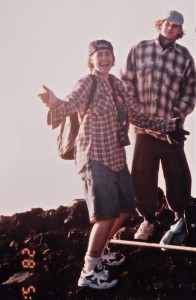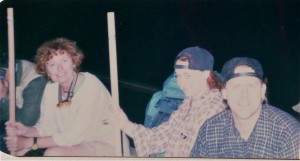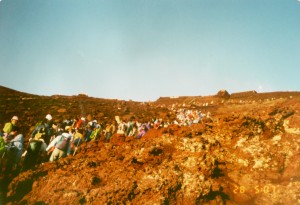My love affair with Mount Fuji began one crisp November morning in 1995 as I pedaled to work from my home in the Tokyo suburb of Fujiki-Kinome. When I reached the middle of a rickety old bridge I’d been crossing every workday for at least a month, the stunning peak of Mount Fuji leapt into view, startling me so much that I almost fell off my bike. How could I have missed the spectacular snow-capped monolith? I soon discovered that Fujisan, as the Japanese respectfully refer to her, often ducks behind a drape of mist, clouds or pollution.
I began to notice that a peek at the mountain made my heart swell. My days improved once I’d caught a passing glimpse on my run along Kawagoe River, on my bicycle ride to work, or as we passed Fujimino (View of Mount Fuji) by train, on the way to Tokyo. I decided nothing would do but to meet the Old Lady, and conquer her.
Colleagues at work offered tales of climbs gone wrong. Michael had endured a freezing night climb to find zero visibility at the top. John knew a guy who had tripped on the way down and broke his leg. “It’s not worth the effort,” said Rachel. “It stinks up there,” chimed in Emma, “and it costs a fortune to get there.” Undeterred, I organized a small climbing party for an evening excursion.
I convinced my 25-year-old daughter Bonnie and three fellow teachers, all men under 30, to take the challenge. I’d have to keep pace with a healthy, fit group, but I thought I could do it. We took the three-hour bus ride from Shinjuku, in Tokyo, to the fifth station, a rest area well above the actual foot of the mountain at 8,000 feet above sea level, where everyone starts walking. The tenth station is at the summit, at 13,000 feet.
We’d heard that the two-mile trek took about five hours, but allowed ourselves two extra hours to ensure we’d witness the sunrise from the summit. We stocked up on lightweight nibbles, not wanting to carry anything too heavy in our backpacks, which already held layers of clothing for the cold weather on top. We purchased walking sticks adorned with tiny bells, miner headlights to wear on our heads in lieu of carrying flashlights, and lightweight plastic raincoats.
We started at about 10 PM, the time I’m usually thinking about bed, but exhilaration lightened our work, and the going seemed easy. We began to wonder if we should toss the walking sticks. Perhaps the climb would be merely a jaunty uphill stroll. We overtook a slow but steady group of seniors, whole classes of kids in school uniforms, families and individuals.
Bonnie and a long-legged British friend, Mark, set a fast pace, followed by me and Nick, another Brit who was visiting his girlfriend in Japan. Geoff, a strapping American guy, brought up the rear. Nobody complained for the first hour or so. As we progressed, though, Geoff, the only smoker among us, began huffing and puffing. I fell back to give him some encouragement, and he confided that he was afraid of heights. I knew the job of coaxing him along would fall to me, the only mother in the group.
Our early exhilaration waned a bit as the climb got progressively harder. Within two hours, Geoff was a mess. I had to coax him around every sharp turn, prod, push and pull him over each obstacle to keep up with the others. As large boulders that required actual climbing replaced the easy dirt trail, we congratulated ourselves for having purchased the walking sticks.
Somewhere along the way, I began humming “Jingle Bells.” Why on earth am I singing a Christmas song in the middle of the summer, I asked myself. I soon realized why: my Christmas spirit was induced by the sound of thousands of walking stick bells tinkling up and down the mountain.
Trudging up a mountain burns up a lot of energy, and before long we’d depleted our rations. The good news was there was food for sale at each station. The bad news was the outrageous price of a simple meal. One thousand yen (ten US dollars) bought a cup of ramen curry, the cheapest of the offerings. We would have paid any price.
Our rest stops lengthened as the climb increased in difficulty. Soon we noticed the tribe of seniors we’d passed earier trudging past us as we dawdled on benches, wondering if we’d ever see the top. That was all the impetus we needed to jump up and continue upward. No way that group of septuagenarians was going to best us.
Oxygen deprivation can be a problem near the top. A climber’s breathing may become difficult and labored, or she may experience feelings similar to drunkenness. Of our party, only Geoff wished he’d bought a can of oxygen at the gift shop. The rest of us fell into a state of extreme silliness. If we’d been in our right minds, we might have turned around and headed home. In fact, Geoff might have turned around anyway, except that the trail is a one-way street, and he would have faced difficulty going in the opposite direction from everyone else in the dark. Besides, I wouldn’t let him.
We began to notice that we were in the clouds. All around us floated a mist we could almost reach out and touch. And then we caught sight of the best view of the night sky ever. We could see the Milky Way and all manner of stars with the naked eye. Luckily for Geoff, we couldn’t see down the mountain.
As we neared the peak, we slammed into a staggering crowd that resembled a multi-car pile up on a highway. We began to panic. Was there enough room up there? Could we leapfrog over this logjam? We’d come so close, and the sun threatened to show itself before we could get there. Why hadn’t any of the nay-sayers warned us?
But the sunrise was no less spectacular from not-quite-the-top. By 5:30 AM we had joined our fellow-climbers on the circus that was the summit of Mount Fuji. Everywhere we looked, folks stood in long lines for food, souvenirs or toilet facilities. We pondered the question of how they ever got all of the stands, food and toilets up there, considering we’d just about hauled ourselves.
As I milled among fellow climbers, I noticed a woman wearing a Temple University sweatshirt. An exchange of greetings confirmed that she had indeed graduated from my alma mater. Was the world really that small, I wondered.
We lingered for about an hour– just long enough for my joints to begin to stiffen after the arduous all-night climb, then we began the torturous descent. We staggered, skipped or slid on the downward path of loose gravel studded with bits of volcanic rock, in long zig-zag lines that seemed to stretch into infinity.
I grabbed onto anyone who’d let me. Geoff had recovered and taken the lead, the ingrate. I fell several times and began worrying about breaking my bones. All the way down people were merry. Japanese folks beamed at us and greeted us with shouts of “Otsukare sama deshita,” the traditional Japanese after-work salutation that means, loosely translated, “Good job!”
Despite the universal good cheer, I began to imagine myself in a Sartre play. What if I’ve died and gone to hell, I asked myself. What if I have to keep walking and falling down this mountain forever and ever?
Somehow, we dragged ourselves to the bottom and collapsed in the first clearing we came to. We decided to take the train instead of waiting five or six hours for the next bus. I found I could hardly manage to board the train. Luckily, it was empty, and we all sprawled out full-length on the long benches. We were the walking wounded. I began hatching a plan to call in sick on the following day. But even as I moaned and groaned I knew one thing: This was a trip I’d never forget. Would I do it again? To quote an old Japanese saying: If you come to Japan and don’t climb Mt Fuji, you’re a fool; but if you climb it more than once, you’re an even bigger fool.






Great story wish I was there.
@jrkaiser Thanks, Honey. Too bad we couldn’t climb last year, but maybe it was lucky.
Great one, Mom! Why do I have no memory of having had a walking stick? When you first mentioned them I thought,”Yeah- everyone except me had one!” If not for the photo, I would’ve fought you on it…..
Also thanks for not mentioning how awful and grumpy I was on the way down- you really are so sweet!
One more thing- I remember the rocks on the top being really beautifully coloured- rusty reds and blues like I’d never seen. I took a handful of them with me, but when I got to the bottom and pulled them out to admire them they had reverted to being plain, old, brown, mud-coloured rocks. Serves me right for trying to take a piece of Fujisan with me!
Glad you liked it, Bonnie. That’s funny about the walking sticks. I remember the brightly colored rocks too. I think I cut something about them
from the piece. I brought one home too, and though it turned brown too, I kept it for years, I think I finally lost it when we moved here.
Nice blog Myra … I even started to feel nostalgic about that grim soulless altitude sickness pilgrimage.
Jack – don’t feel too bad about missing out on the climb last year. Myra paints a romantic picture but a 30-shot tequila hangover will get you somewhere close to re-creating the experience. The mountain’s much more beautiful from a distance.
Hey Bonnie, hisashiburi … genki? If it helps, I don’t remember you using the stick as crutch, more a means to encourage those of us not keeping up your pace.
Mark
@MAH Hey Mark, glad you found the blog. Grim, soulless, altitude-sickness pilgrimage is one way to put it! I’d expect that from a Western prince. LOL
I loved this. You put me right there on the mountain with you and your team. And that’s really saying something because I would never, ever, really be there! Congrats on another fine piece of work. (I will continue to live vicariously through your adventures, large and small.)
Thanks, Marcy. I was worried about this one being too long, so I’m especially happy to learn that you liked it.
Why would you never do it?
Myra